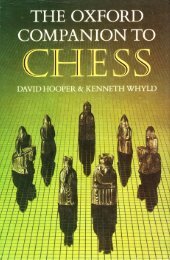You also want an ePaper? Increase the reach of your titles
YUMPU automatically turns print PDFs into web optimized ePapers that Google loves.
266 PROBLEM HISTORY<br />
tines combiniig lw. or more elemenls in new<br />
ways. From 1913 <strong>to</strong> I924 these devclopmcnts wcrc<br />
encouraged <strong>by</strong> rbe GooD.oMr^<br />
ouB. (Foi exanples see INALVE, PrN !hrE, and<br />
s.nr.tuANN DrF.Nc. ) Thc same tactic,l delices<br />
wcrc Bed <strong>to</strong> enrich three-novers. Economy of<br />
lorce became of increasing importance. <strong>to</strong> wbich<br />
end MLRrDrrs rourneys Nere inlrodu@d in 191,1.<br />
Conposeis would often atloadu.lsin theBy pLAy<br />
rltbe. than add exha ne. <strong>to</strong> prevenr then.<br />
Inhoduoory play and rRrNGr v<br />
oI fashion. From about i910 Britnh conpose$<br />
specialized on .UNGED puy aml BLoc( problems.<br />
Shortlv hcr.re the Fnst World Wa leN<br />
delorees nNcsiieatcd R.f,Ror;RADE ANALyss and<br />
fkoBlrMs and self<br />
mates bad been known since nedieval tines and<br />
EELPM{ES since 1854 i these and other tinds oflairy<br />
problem j.leresled shl.kman and rhrouch hin<br />
DAlsoN, who madc thh lield his spcciality from<br />
r9ll.From l9l9inthcpaeesolrheChes A atew<br />
he coDductedthe 6rstlone'runningcolunndevoted<br />
<strong>to</strong> iairy problens and tbese became esrablishcd<br />
in contincntal Europ. in thc 1920s. largelythrough<br />
CoBposing technique in all branches ot the arr<br />
continucd 10 improle- nolably on accounl ol thc<br />
lead given <strong>by</strong> the exceplionally talentcd LosHrNs(y<br />
in the 1930s. Around lhis time lhe fashion lor<br />
nodel nites praclically ended elcepr lor Bohenian{tylc<br />
composirions For tao-movcB DUALbecame<br />
popular in rhe<br />
^vorDAN.EandcoRR..noN<br />
1930s, changedplaywithspecialregard <strong>to</strong>nY Put<br />
in rhe l95lk .y.rr. prAy soon alierwards Morcmoven<br />
arc siill lor thc most pa in accordance<br />
with tbe New Geman style Three-movers give<br />
scope lor . wide .ange oi rhemes, norably those<br />
containing crjtic.l play, that can.or be shown i.<br />
feae. moles. In the earlyyears oithe 20th century<br />
three nole oilen consisted of several ladalions<br />
shoNinC a nulriplicity oliacdcal elenents, sinitar<br />
in kind but more complcx than those of thc<br />
two-mover. Laterpuritrof aim, a spin-ofi from the<br />
logical problen. becane more corrspicuous, a<br />
mcrc 1wo rarialions being lcceprable on occasr.n<br />
r.tz<br />
y.%w1& tt*-<br />
%%ffi'tffi"<br />
'ffi'/& % 'ffi<br />
% ?&Hl%tr/*A<br />
ry /ry, %f%<br />
%6ffi8% 'il<br />
A more nover <strong>by</strong> {rHM thal won li6l prize in the<br />
Leipzie Olydpiad <strong>to</strong>umey, 1160 $rhile\ naring<br />
thrcats (othcr than thc promolion oi the lpawn)<br />
arcBxe? and R\I5. delended <strong>by</strong>Blacki rook al e2<br />
and his bishop respc.tivcly. I Kc6 Ba4+ 2 b5 (a<br />
DEcoy) 2. Bxb5+ 3KlsBd3(here thebishop<br />
inrerlcrcs with rhe rook ar a3) ,l Kgs Rg2 + 5 Ng4<br />
(arotherdecoy) 5. . . RxC4- 6K18, andilBlack<br />
delendse<strong>The</strong>cutsoff hndelenceott5,e.g. 6..,<br />
Re4 7 R\t5. Ihc piayshowsaRonan lheme.with<br />
decoy ol tqo pieces. <strong>The</strong> EEMATC rRyi I KgSi<br />
nimics rhe key i alter L RE2+ 2 Ng4 R\94+ 3<br />
Krx Bl.c* ..uld dcfcnd bv 3 . . . Re3.<br />
+3<br />
t<br />
7z<br />
A problem <strong>by</strong> G. F. ANDERSoN and the Anerica.<br />
composcrVinccnt l-aniusEalo. (r915-62), Bfli6h<br />
Crers &dgdzi,c, 1953. <strong>The</strong> keris l Bbl and in sn<br />
lanations Black. <strong>by</strong> his own acrions, depnles<br />
hinsellol a check <strong>by</strong> one olhis rooks on a5, g8, or<br />
1...Bxa5 2 Nxd4<br />
1...Nxa5 2Nd6<br />
1.. Bc5or1...B.? 2 Nc7<br />
1...Nc5 2Nc3<br />
1... Nd8 2gxh6<br />
1... Nd6 2Nt8.<br />
<strong>The</strong> collalora<strong>to</strong>s, who spcnt thrcc hmd.ed<br />
hours composnrg ihis hiehly complex problem.<br />
tded <strong>to</strong> sho{ in as nan} vanations as possible a<br />
thene called checl preventiod. Other variadons<br />
begi.1...llc7 2Rxd5- 1. Rxb5 2R15+- I<br />
..Rd 2 Nxc5. 1...d3 2 Oh,1+, 1...<br />
Rgl 2Rh4+,and1. hxg5 2 Rhag5<br />
H. G. M. Weenink, Ih? Cr€ss l<strong>to</strong>bkn \1926) is a<br />
PROBLEMS, ORTTIODOX, S<br />
tr<br />
%<br />
t<br />
PROGRESSM CHESS! a. unorthod.x gamc in<br />
which White Dakes his first mo!e. BIa.k makes<br />
two sNcLE MovEs in reply, Wrile then makes three<br />
single Boles- Blac( Io!r. andsoon Check may 6e<br />
givcn only on the lasi ol a series ol si.gle-moves<br />
and must be evaded on the 66t move ol lhe<br />
folldwingseries. <strong>The</strong> Frenchexpei<strong>to</strong>n unoahodox<br />
ganes Joscph Boycr (lli95-1961). qho suge*l.d<br />
thc namc progressive.hes. said it was knoxn in<br />
FraDce as Scotch ches becau<br />
said that he had seen it played Nhen he visiled<br />
Scotlandin i947 <strong>The</strong> gane is also c.lled rlr:lri€a




